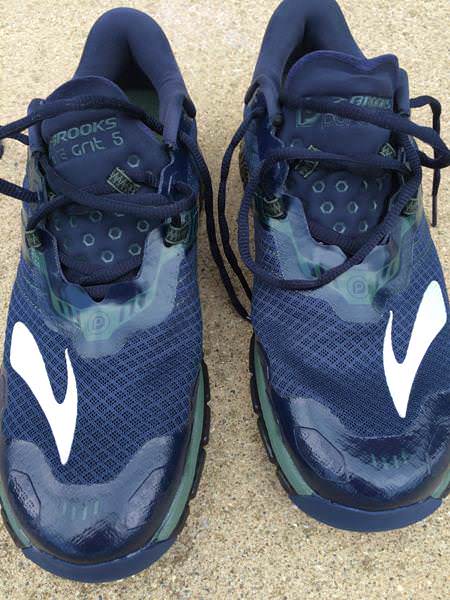
The PureGrit’s hex lug design is unchanged from the previous model. While Brooks vows that it will deliver maximum traction across any terrain, I did not find that to be the case.
I ran more than half of the 50+ miles used for this testing on what I would consider moderate or slightly above moderate trail elements. There was a combination of mud, sand, rocks, dirt and multiple water crossings.
While the traction was enough to keep me stable, there was a noticeable drop off in performance when dirt turned to the slightest mud patch.
The shoes were simply not sophisticated enough to allow me to power through the challenging terrain. It was a tradeoff — stability for speed — that I am unwilling to make on slightly above average moderate trails.
When I found areas to sprint through, I found it challenging to hit my top trail speed in the PureGrits. Trail runners look for shoes that can fulfill their perfect balance between speed and stability.
For me, these shoes offered comfort and protection from the trail. But they lacked the ability to maneuver through more challenging sections of the trail and allow me to hit my higher gears in the sections that allow for speed.
Brooks PureGrit 5 General Info
The Brooks PureGrit 5 is billed as a lightweight trail shoe that can handle various types of terrain.

Brooks PureGrit 5 – Toe
Brooks has continued to make improvements from the 3.0 version, and is clearly headed in the right direction for comfort and use on basic trails.
The PureGrit 5 is roughly the same weight as its predecessor — 9.9 ounces for the men’s version (compared to 10.1 ounces in the PureGrit 4) and 8.3 ounces for the women’s, which is a negligible 0.1 heavier than the previous model.
Each has a 4 mm drop, unchanged from the past version. Among its competitors are the New Balance MT 101, Altra’s Superior 2.0 and the North Face Ultra MT.
Brooks PureGrit 5 Sole Unit
Brooks takes great pride in its 3D hex lug concept. When it comes to beginner runners and/or trails, the PureGrit is worth the investment.

Brooks PureGrit 5 – Sole
The PureGrits can easily handle paved trails, dirt trails, cross-country courses and minimal mud, water and rocks.
They do not give me the confidence to try out during my next ultra, which has just under 4,000 feet of elevation gain and “only” gets two of out five stars for being a technical course.
I’ve really tried to come up with a type of race that I would use the PureGrits in and have not thought of any. Brooks did make some positive changes, incorporating a sturdier heel and widening the footprint ever so slightly.
Still, the shoe is rather narrow fitting and has a certain stiffness to it. Those who have experimented with wider toe boxes would be less likely to embrace the PureGrit style.
I infrequently wear models with wider toe boxes; even so, my toes were calling out for more room during my longer runs in the PureGrits.
Brooks PureGrit 5 Upper Info

Brooks PureGrit 5 – Heel
Brooks is continuing to tweak the upper in its PureGrit model. Many runners wearing the PureGrit 3.0 model reported dealing with a fitting issue with the tongue — specifically the tongue would flap around.
So for the 4.0 version, Brooks resolved that issue by making the tongue wider and more padded. For the 4.0, Brooks says it updated the upper portion in conjunction with the hex pattern on the outsole.
For the newest version, Brooks has updated the PureGrit with a new upper aimed at preventing debris from getting inside. Gone is the Nav Band strap.
In its place, is a flat webbing tied into the laces — one of the first things that struck me as I removed the shoes from the box. The webbing is comfortable without sacrificing security or fit.
At the base of the shoelaces, the PureGrit features a dust shield, which does a fine job of keeping dust, dirt and other debris from infiltrating the top of the shoe.
Additionally, around the edge of the shoe, Brooks has added what it calls a “reinforced abrasion zone,” designed to keep away mud and water.
The aforementioned features fulfilled their missions of keeping my feet free from the trail elements. I did find the heel to be rather low and lacking in support — this could explain why I was not able to push into a higher gear.
Other than that, the enhancements made to the PureGrit 5 were well done. And, while I was at first surprised by the few laces, they actually worked well for a comfortable fit. Not too loose, not too tight.
Brooks PureGrit 5 Conclusions
When I was first approached about testing out two pairs of Brooks — including the PureGrit 5 — I was hesitant.
My only previous experience with Brooks was when I was a newbie runner about five years ago. I tried a pair of Brooks road shoes, immediately developed shin splints and reverted back to another brand.
But, now as a more experienced runner, I thought I would give Brooks another shot. Neither of the Brooks trail shoes I tested gave me shin splints or other ailments.
I quickly found much more to like with the Mazamas (review coming soon) than the PureGrit, especially in terms of speed.
The PureGrit is not a bad shoe but it does not meet my needs on the trail. I will likely continue to use the PureGrits for training runs, primarily on the local high school cross-country course and other minimal trails.
For those who are looking for their first trail shoes or runners who prefer softer, gentler trails to anything resembling a technical one, the PureGrit should meet your needs.
These shoes will provide comfort and protect your feet from natural obstacles that you will meet on mild trails.
We thank the nice people at Brooks for sending us a pair of PureGrit 5 to test. This did not influence the outcome of the review, written after running more than 50 miles in them.
























